I have been to Brussels and Brugge before and I had the chance to visit them again. This time, I can say that I traveled in more detail to prepare a Brussels and Brugge travel guide for the blog. In this guide, there will be information such as transportation, accommodation, eating and things to do in both Brussels and Bruges. I thought that a Brussels travel plan would be incomplete without Brugge, so I wanted to prepare both together, here is my Belgium Travel Guide.
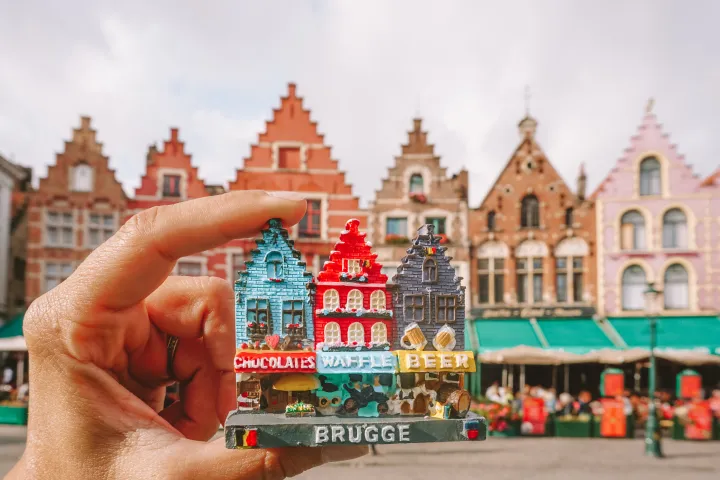
Brussels Travel Guide
First of all, I share the informations you may need for your trip to Brussels.
Brussels Accommodation Guide
While planning a trip to Brussels and Bruges, I decided to stay in Brussels because it feels safer to stay in a big city with a child. I was planning to stay in Brussels for three nights, but since I booked last minute, I could not find a hotel that I liked for 3 nights in a row. So I stayed in two different hotels, both modern and stylish hotels with their own style: Jam Hotel and Zoom Hotel. Both of our experiences were smooth and enjoyable, you can check them out. Below I will share the ideal neighborhoods for accommodation in Brussels and other hotels I liked during my research.
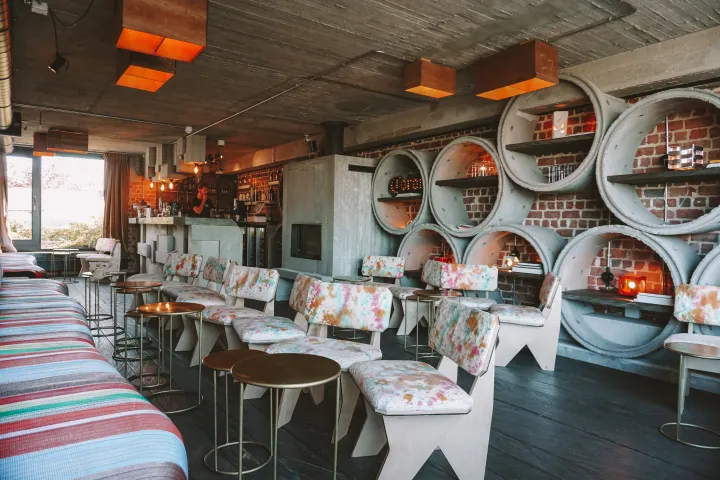
Where to stay in Brussels?
Historical Center: The best area for first-time visitors to Brussels. It is close to Grand Place and many tourist attractions. You can check here for hotels here.
Ixelles: An ideal place for those who like to eat and drink. Full of local restaurants and cafes. You can check here for hotels here.
Saint-Gilles: A quiet and safe neighborhood for families. There are parks and theaters. You can check here for hotels here.
Saint-Gery: A nice neighborhood for nightlife. There are many bars and clubs. You can check here for hotels here.
Dansaert / Saint Catherine: A neighborhood that stands out with its central location and social atmosphere. You can check here for hotels here.
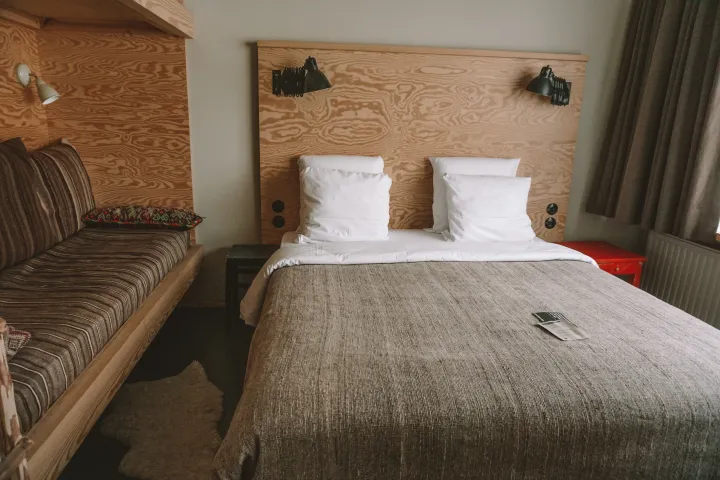
Sablon: The best neighborhood for shopping lovers. It has a historical and elegant atmosphere. You can check here for hotels here.
Marolles: An ideal neighborhood to experience the local culture. Famous for its markets and second-hand shops. You can check here for hotels here.
European Quarter: I would say the safest neighborhood, it is home to the European Parliament. There are museums and parks. You can check here for hotels here.
Uccle: An ideal neighborhood for art lovers, famous for its Art Nouveau architecture and green areas. You can check here for hotels here.
Fontainas: Famous for its colorful bars and nightclubs and known as an LGBTQ+ friendly area. You can check here for hotels here.
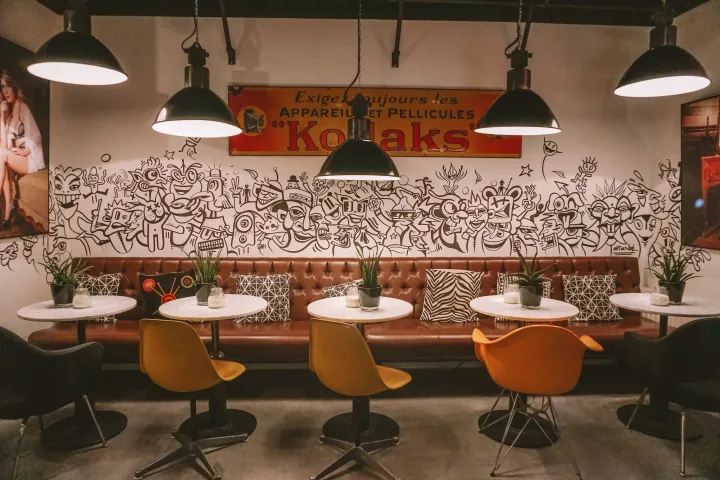
Brussels Hotel Recommendations
Budget Friendly Hotels in Brussels: Hotel Aqua by HappyCulture, Hotel La Grande Cloche, MEININGER Hotel Bruxelles Gare du Midi, Hygge Hotel
Mid-range Brussels Hotels: LATROUPE Grand Place Hostel, The Hoxton Brussels, Radisson RED Brussels, Hotel Hubert Grand Place
Luxury Hotels in Brussels: Hotel Le Châtelain, Sofitel Brussels Europe, Radisson Collection Grand Place Brussels, Le Louise Hotel Brussels
You can find the most suitable accommodation options for you in Brussels here.
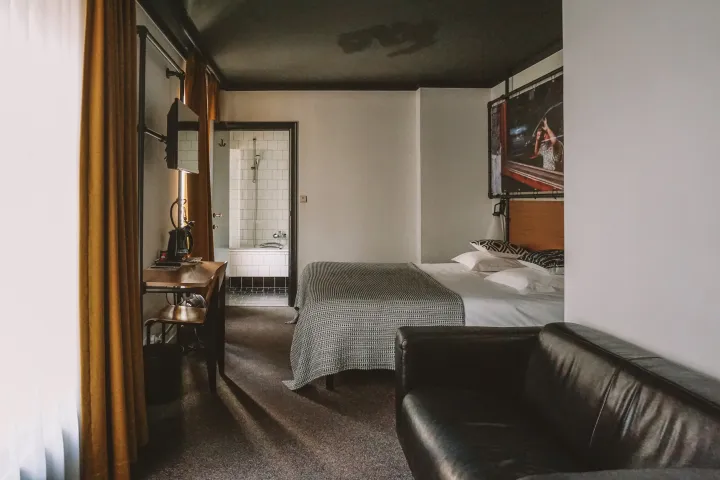
How to get to Brussels? Brussels Transportation
There are direct flights to two of Brussels’ Airports: Charleroi Airport, which is 60 km away from Brussels. and the main airport Zaventem, which is only 12 km away from the center. First of all, let me talk about transportation from both airports to the city center, then I will explain the public transportation in the city.
How to get to Brussels from Charleroi Airport?
- Flibco Shuttle: Serves between Charleroi Airport and Brussels Midi Train Station. Buses depart every 30 minutes and the journey takes about 1 hour. Tickets can be purchased online or at the airport. The ticket costs 19.95€ one way.
- Train First you need to take the TEC buses to Charleroi-Sud Train Station, then take the train to Brussels city center. Total travel time is around 1.5 hours.
- Door2Gate: A shared or private minibus service takes passengers from the airport to their address in Brussels. It is a comfortable and affordable alternative when shared.
- Taxi: Quite expensive but of course the most comfortable alternative, you can expect at least €100.
How to get to Brussels from Zaventem Airport?
- Train: Brussels Airport-Zaventem Train Station is located on the lower level of the airport. Trains depart every 10 minutes and take about 18 minutes to the city center. Tickets can be purchased from machines at the airport or online. Price: 10.30€.
- Bus: STIB/MIVB buses run regularly from the airport to the city center. Buses depart every 20-30 minutes and the journey time is approximately 30 minutes. Ticket price is 7€.
- Taxi: It takes about 30 minutes to reach the city center by taxi and costs around 45€.
- Private Transfer and Shared Car Services: Services such as private transfer or Uber are suitable for those who want comfortable but more affordable transportation than taxis.
Public Transportation in Brussels
The public transport network in Brussels consists of STIB/MIVB metro, tram, bus, SNCB train, De Lijn regional bus and TEC regional bus.
- One-way ticket (1 hour duration): 2,40 €
- Five travel tickets: 8 €
- Ten travel tickets: 15,60 €
- One day travel card: 7,80 €
In Brussels you have to have your ticket validated, if you get caught in a checkpoint there is a fine of 107€.
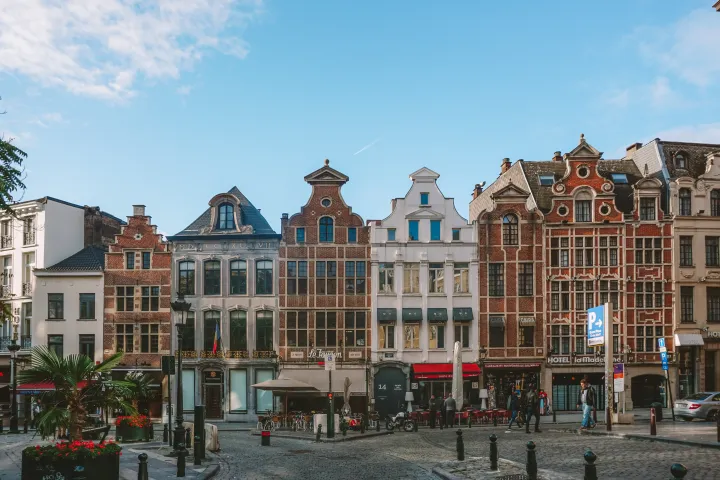
Where and What to Eat in Brussels? Brussels Food Guide
Waffle: You know that Belgian Waffle is world famous. There are two types of waffles in the country and they are slightly different from each other. Brussels Waffle stands out with its rectangular shape, fluffy and light texture, while Liege Waffle is round, smaller, denser and sweeter.
Where to eat the best waffle in Brussels? Maison Dandoy and Veganwaf for vegans.
Moules Frites: Considered the national dish of Belgium, mussels and fries should be first on your list. They make it really well. In the classic recipe, mussels are cooked with white wine, garlic and herbs and served with crispy fries.
Where to eat the best mussels in Brussels? Chez Leon with every kind of mussels you can think of.
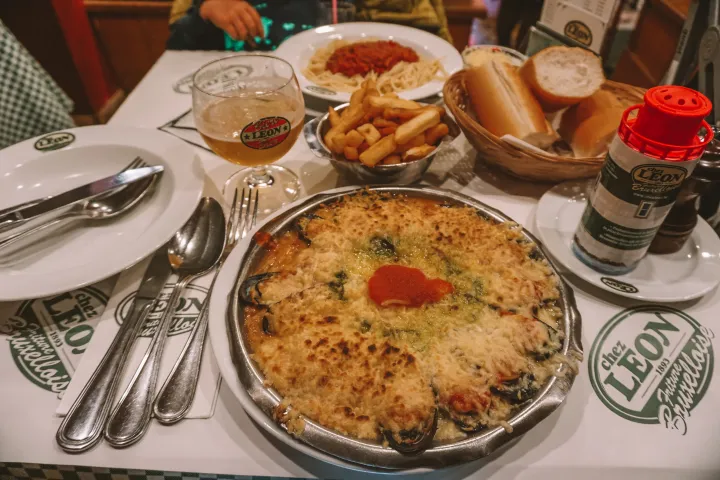
Belgian Beers: Belgium is famous for its rich beer culture and the country produces hundreds of different types of beer. Trappist beers are the most well-known types of beer produced in monasteries. You can try brands such as Chimay, Westvleteren and Orval. I also recommend tasting local beers such as lambic, witbier and dubbel.
Where to drink beer in Brussels? Moeder Lambic and Delirium Cafe with more than 2000 beer options.
Belgian Chocolate: One of the first things that comes to mind when you think of Belgium is of course chocolate. World-famous Belgian chocolates, with their quality and variety, are a must-try and a must-take on your way back.
Where to buy chocolate in Brussels? Pierre Marcolini, Chocolatier Leonidas and Chocolaterie Mary.
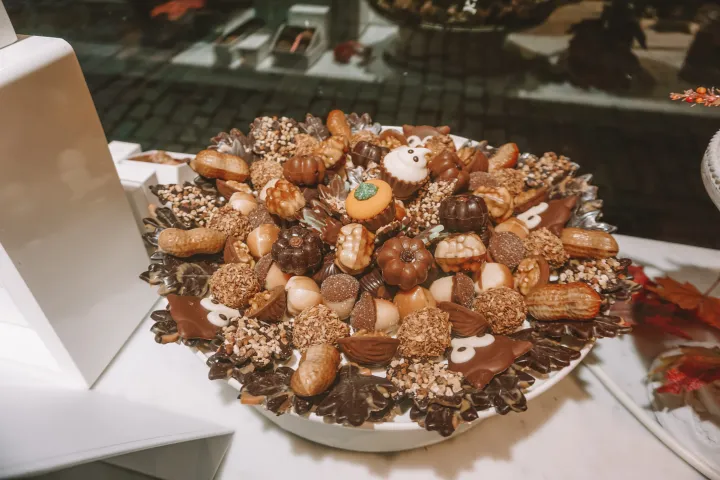
Brussels Travel Itinerary – Brussels Things to Do
Grand Place: The main square of Brussels, one of the must-see places in Brussels, is a UNESCO World Heritage Site. The Brussels City Hall and the guild houses are located here and together they create a very photogenic image. Every year there is a Christmas Market and every two years there is a Flower Carpet event. In 2024 it will be from August 15th to August 18th, so keep that in mind. There are also light and music shows in the evenings, so be sure to see it at night.
Manneken Pis: A statue of a little boy peeing, which I can call the symbol of Brussels. According to legend, a little boy extinguished a fire by urinating and saved the city, which is why this statue was erected. The statue is normally naked, but they dress it up in different costumes throughout the year. So far they have accumulated more than 1000 outfits. If you are interested, you can visit the GardeRobe Manneken Pis museum to see the costumes. There are also statues of Jeanneke-Pis (peeing girl) and Zinneke Pis (peeing dog) in the city.
Royal Palace: Belgium is a monarchy and in the center of Brussels is the Royal Palace. The royal family lives in Laken and the palace in the center is the king’s workplace and used for official ceremonies. The palace is normally only visible from the outside, but it is open to the public from July 21 (Belgian National Day) until the end of August. It is free to visit every day except Mondays, so keep this in mind if you are in Brussels during this period.
Mont des Arts: A hill with one of the best views of Brussels.
Royal Gallery of Saint Hubert: Brussels’ historic arcade, with cafes, restaurants, chocolatiers and some shops.
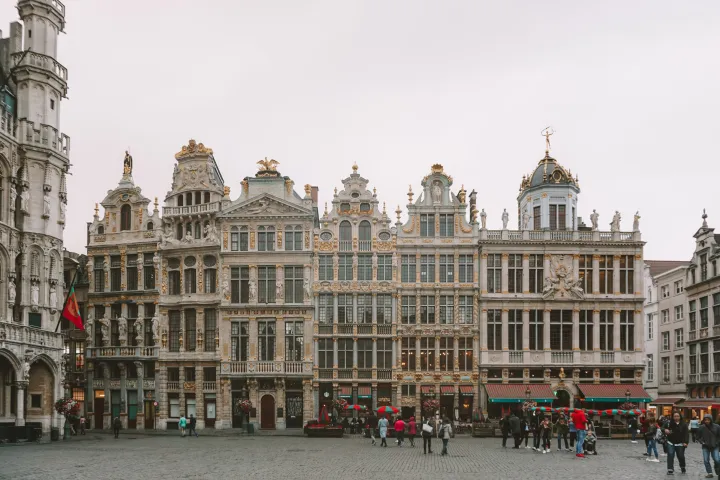
Atomium: One of the most striking landmarks of Brussels, the building was built for the 1958 Expo Fair. The nine spheres in the structure represent an iron crystal magnified 165 billion times. Located in the west of the city, you can reach the building by metro or hop-on hop-off bus. Inside there is a museum, a panoramic restaurant and an observation deck with 360° views. It is also impressive with its night lighting.
Mini-Europe: It is located next to the Atomium and contains miniatures of important European buildings. With 1:25 scale models, you can see famous buildings such as the Eiffel Tower and Big Ben. This open-air museum for all ages is especially suitable for families with children. It is more affordable if you buy a combined ticket for Atomium and Mini-Europe.
Royal Belgian Institute of Natural Sciences: Home to Europe’s largest dinosaur collection, this museum is a must-see especially for families with children. It is a bit far from the city center.
Cinquantenaire Park: A huge park outside the center of Brussels, within walking distance of the EU Zone. This is the park of the 50th anniversary of Belgian independence. The park features a large triumphal arch with three arches and some museums: Royal Museum of the Armed Forces and Military History, Autoworld with a collection of vintage cars and the Museum of Art and History.
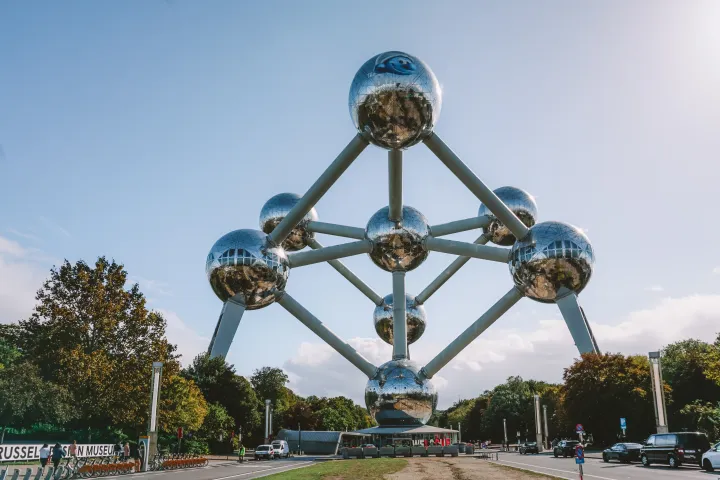
Bruges Travel Guide
From here on, I share the information you may need for your Bruges trip.
If you want to stay in Bruges, you can look here for the most suitable accommodation options for you.
How to get to Bruges? Brugge Transportation
First of all, let me share how to get to Bruges from Brussels.
Train: The fastest and easiest way to get to Bruges from Brussels is by train. There are continuous services from Brussels Central Train Station (Bruxelles-Central) to Brugge Train Station. The journey takes around 1 hour. You can buy tickets from SNCB’s website or from the ticket machines at the stations. The ticket price is 14.30€.
Bus: FlixBus and other bus companies go from Brussels to Bruges. The journey takes about 1.5-2 hours and ticket prices usually vary between €5-10.
Car Rental: Brugge is about 100 kilometers from Brussels, you can reach Bruges in 1-1.5 hours from the E40 highway by renting a car.
You can easily visit the touristic places on foot in the city transportation. For public transportation, let me give the necessary information very briefly. You can use bus number 1 or 2 to reach the historical center from the train station. One-way bus tickets cost 3€ and daily bus tickets cost 5€.
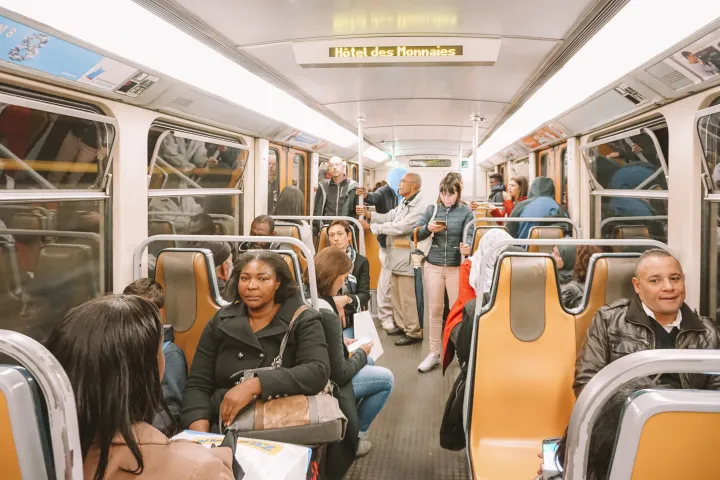
Where and What to Eat in Bruges? Bruges Food Guide
Where to eat the best mussels in Bruges? Poules Moules
Where to drink beer in Bruges? 2BE Beer Wall and Bieratelier
For those looking for a fine dining experience, the Michelin-starred Zet’Joe is a great option.
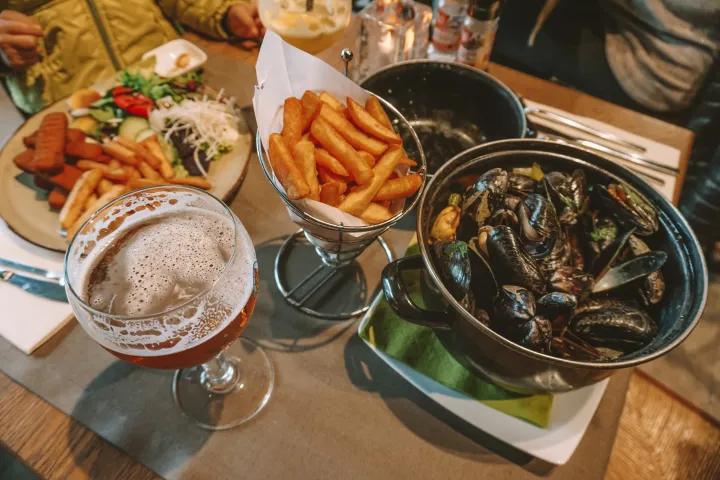
Where to eat the best waffles in Bruges? Chez Albert and House Of Waffles
That’s Toast is a very nice place for breakfast, coffee and brunch.
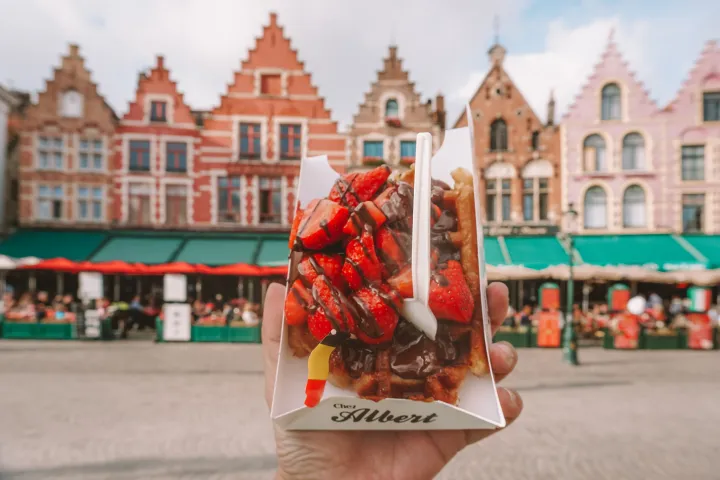
Bruges Travel Itinerary – Bruges Things to Do
Belfry of Bruges: The symbol of Bruges, the 83-meter high bell tower, also known as Belfort. Dating back to the 13th century, the tower was first built around 1240. You can go to the top of the tower, but you have to climb 366 steps.
Grote Markt: The most lively place in Bruges, Markt Square is surrounded by iconic houses and restaurants. Since 958, it has been the market place of the city. The Bell Tower is also located here.
Historium Bruges: A history experience museum in Markt Square that takes you back to medieval Bruges. The story built around Jan Van Eyck’s famous painting ‘Virgin and Child with Canon Joris Van der Paele’ allows you to live the 14-15th century.
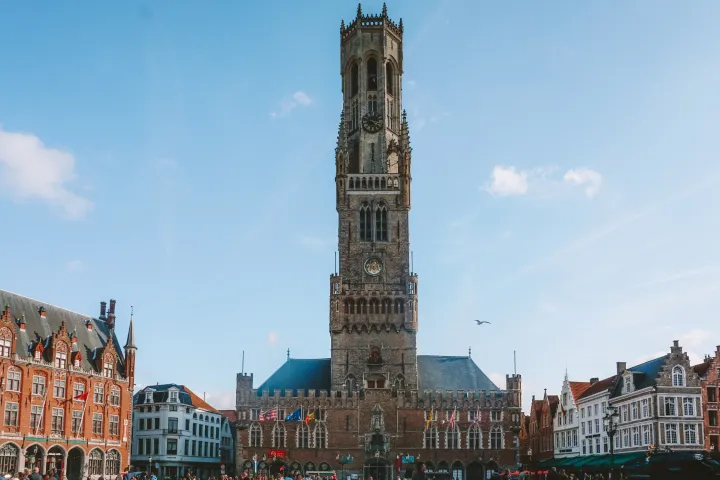
Burg Square: Another important square very close to Markt Square. Some of the city’s most important and photogenic buildings such as the Town Hall and the Basilica of the Holy Blood are located here.
Basilica of the Holy Blood: The Basilica of the Holy Blood, located in Burg Square, has a cloth in a bottle that is thought to be stained with the blood of Jesus. The basilica consists of two parts, the 12th century Chapel of St. Basilius and the Chapel of the Holy Blood.
Rozenhoedkaai: This place has one of the most iconic views of Bruges. It is especially beautiful for taking photos at sunset.
Bruges Begijnhof (Beguinage): This is one of the most peaceful places in the city. It consists of a monastery and its garden surrounded by white painted houses. Founded in 1245, today it is a place where nuns and some women in need of asylum live.
Brugge is a city of canals. With so many canals running through the city, taking a boat tour is of course one of the most popular things to do in Bruges. It is a pleasure to see the city through the water. The tours, which last about 30 minutes, take place between Jan Van Eyck Square and Minnewater and there are live narrations in various languages with a guide. The cost is around 15€.

If there are any other questions or additions about the Belgium trip, you can leave them as comments.
Don’t forget to follow me for more photos and to be informed about my future posts!
Instagram: lifetime.journey
Tiktok: ihdcnwbcmw.com
Discover more from LIFETIME JOURNEY
Subscribe to get the latest posts sent to your email.